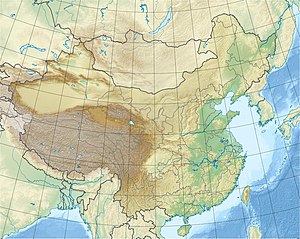 The Tarim Basin, with the Taklamakan Desert, and the location of Xiaohe Cemetery. | |
| Location | |
|---|---|
| Region | Xinjiang |
| Coordinates | 40°20′11″N 88°40′21″E / 40.3364°N 88.6725°E |
| History | |
| Periods | 2000-1000 BCE |
The Xiaohe Cemetery (Chinese: 小河墓地; pinyin: Xiǎohé mùdì, lit. 'little river cemetery'), also known as Ördek's Necropolis, is a Bronze Age site located in the west of Lop Nur, in Xinjiang, Western China. It contains about 330 tombs, about 160 of which were looted by grave robbers[1] before archaeological research could be carried out.
The Gumugou cemetery slightly to the north is also considered as part of the Xiaohe culture.[2]
The cemetery resembles an oblong sand dune. From it the remains of more than 30 people, the earliest of whom lived around 4,000 years ago, have been excavated. The bodies, which have been buried in air-tight ox-hide bags, are so well-preserved that they have often been referred to as the "Tarim mummies".
The Xiaohe remains have attracted considerable attention, particularly because of their "Caucasoid" appearance.[3][4] Analysis of the Xiaohe population's genetic makeup has revealed that they represented a genetic bottleneck, essentially derived from Ancient North Eurasians.[5]
The Xiaohe cemetery complex contains the largest number of mummies found at any single site in the world to date.[6] The bodies are likely to have been transported significant distances for burial at Xiaohe, as no contemporaneous settlement is known to have existed near the tomb complex.
- ^ "Burial Site from the Bronze Age, Lop Nur, Xinjiang". www.china.org.cn. Retrieved 28 July 2009.
- ^ Betts, A.; Jia, P.; Abuduresule, I. (1 March 2019). "A new hypothesis for early Bronze Age cultural diversity in Xinjiang, China". Archaeological Research in Asia. 17: 204–213. doi:10.1016/j.ara.2018.04.001. ISSN 2352-2267. S2CID 134074047.
The Xiaohe culture is known from two key sites, the Xiaohe Cemetery itself (Xiaohe Archaeological Team, 2004; Xiaohe Archaeological Team, 2005; Xiaohe Archaeological Team, 2007) and the cemetery of Gumuguo (Han, 1986; Wang, 2014) in the same region.
- ^ Li et al. 2010: "These mummies, especially the prehistoric Bronze Age 'Caucasoid' mummies, such as the 'Beauty of Loulan', have attracted extensive interest among scientists regarding who were these people and where did they come from."
- ^ Shuicheng, Li (2003). Bulletin. Stockholm: Fälth & Hässler. p. 13. "Biological anthropological research indicates that the physical characteristics of those buried at Gumugou cemetery along the Kongque River near Lop Nur in Xinjiang are very similar to those of the Andronovo culture and Afanasievo culture people from Siberia in Southern Russia. This suggests that all of these individuals belong to the Caucasian physical type.¹² Additionally, excavations in 2002 by Xinjiang archaeologists at the site of Xiaohe cemetery, first discovered by the Swedish archaeologist Folke Bergman,¹³ uncovered mummies and wooden human effigies that clearly have Europoid features [Figure 6.1]. According to the preliminary excavation report, the cultural features and chronology of this site are said to be quite similar to those of Gumugou.¹⁴ Other sites in Xinjiang also contain both individuals with Caucasian features and ones with Mongolian features. For example, this pattern occurs at the Yanbulark cemetery in Xinjiang, but individuals with Mongoloid features are clearly dominant.¹³ The above evidence is enough to show that, starting around 2,000 B.C., some so-called primitive Caucasians expanded eastward to the Xinjiang area as far as the area around Hami and Lop Nur. By the end of the second millennium, another group of people from Central Asia started to move over the Pamirs and gradually dispersed in southern Xinjiang. These western groups mixed with local Mongoloids¹⁶ resulting in an amalgamation of culture and race in middle Xinjiang east to the Tianshan. "
- ^ Zhang, Fan (November 2021). "The genomic origins of the Bronze Age Tarim Basin mummies". Nature. 599 (7884): 256–261. Bibcode:2021Natur.599..256Z. doi:10.1038/s41586-021-04052-7. ISSN 1476-4687. PMC 8580821. PMID 34707286.
- ^ Jan Romgard (2008). "Questions of Ancient Human Settlements in Xinjiang and the Early Silk Road Trade, with an Overview of the Silk Road Research Institutions and Scholars in Beijing, Gansu, and Xinjiang" (PDF). Sino-Platonic Papers (185).

